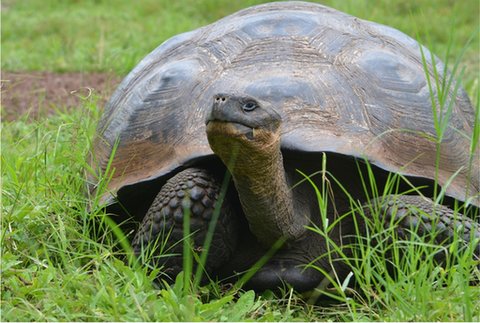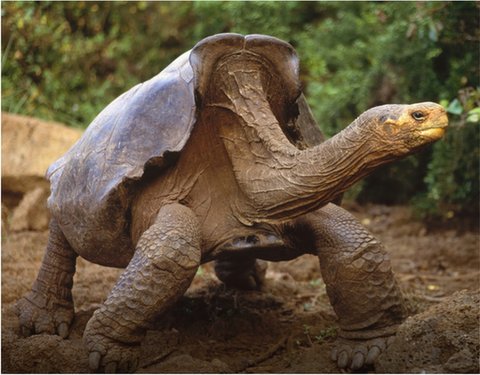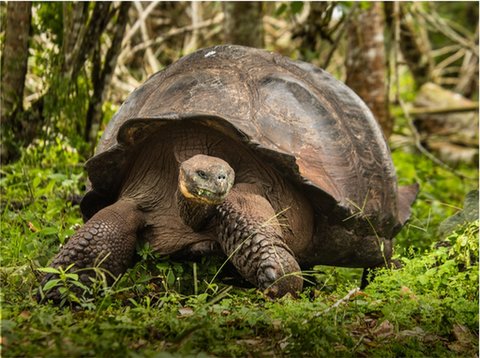LandofGiants
Perhapsthemostwell‑knownspeciesoftheGalápagosIslandsisthegianttortoise.InDarwin’stime,some15speciesexisted.Today,11species remain.
Agianttortoisecanweighasmuchasapiano,hasleatheryskin,andahard,thick shell.Asyoumightexpect,eachspeciesofgianttortoiseissuitedforsurvivalonitsparticularisland.Forexample,thosewithdomedshellscanbefoundlivinginhighlandswithfertilepastures.Theshapeoftheirshellskeepsthemfromraisingtheirheadsveryfar.So,theyneededtofindfoodclosetothe ground.
Thosewithsaddlebackshells—orshellswithanupwardcurveatthefront—canmorefreelystretchtheirnecks.Thesetortoisescanbefoundonislandswithsparsevegetation.Theirshellshapegivesthemflexibilitytoreachforfoodthat’shigherofftheground,suchasbushesandtall cacti.

Galápagosgiant tortoise

gianttortoise withsaddleback shell

gianttortoisewith domed shell
AtRisk
Unfortunately,oneofthetortoise’sgreatestadaptationsbecametheindirectcauseofitssteadydemise.Gianttortoiseshavetheabilitytosurvivefornearlyayearwithoutfoodorwater.Thismadethemvaluabletosailorsandwhalerswhowouldcollecttortoisesfromtheislandssothattheycouldhavefreshmeattoeaton longvoyages.Tortoiseswerealsoexploitedfortheirfat,whichwasusedinlamps.Asmanyas200,000tortoiseswerekilledforthesepurposesformorethantwo centuries.
Thosethatsurvivedontheislandsweresubjecttoinvasivespeciesandpredators.Theireggsandhatchlingswereoftenpreyeduponbyrats,hawks,andpigs.Theyalsohadtocompeteforfoodwithhungry goats.
In1959,theGalápagosNationalParkandtheCharlesDarwinFoundationwereestablished.Soonafter,theTortoiseCenteronSantaCruzwascreatedtoprotectthe tortoises.
TortoisesToday
Today,therearetwoothergianttortoisebreedingcenters,oneonIsabelaandtheotheronSanCristóbal.Toslowthelossofgianttortoises,theTortoiseBreedingCentersbeganraisingcaptivetortoises.Onceatortoisehasgrowntoasizelargeenoughthatpredatorswon’tposeadanger,thecenterintroducesthemintothewild.Bytheendof2017,morethan7,000 youngtortoiseswerereleasedtotheirislandof origin.
Repopulatingtheislandswheretortoiseshavegoneextinctisapriority.ThishappenedonFloreanaandSantaFeinthemid‑1800sandonPintaIslandin2012,withthedeathofLonesomeGeorge.Currently,theSantaCruzhighlandsandIsabela’sAlcedoVolcanohavethelargestpopulationsofgianttortoises.TortoisepopulationscanalsobefoundonSantiago,SanCristóbal,Pinzón,andEspañola.Theirnumberscontinueto grow.
WhoWas LonesomeGeorge?
ThePintaIslandtortoisewasextinct.Thatwasafact.Noonehadseenoneontheislandsince1906.Untila scientistdiscoveredonebyaccidentin1971.ThattortoisewasLonesomeGeorge,andfromthatmomenton,hebecameoneoftherarestcreaturesintheworld.GeorgewasmovedtotheCharlesDarwinResearchStationonSantaCruzandlivedtherefor40 years.Hewasabout100yearsoldwhenhedied.Theworldfelthisloss.GeorgehadbecomeanimportantsymbolforconservationeffortsintheGalápagosIslandsandthroughoutthe world.
